Hope to see anyone in the area at this informal discussion at the Traverse City Wild Birds Unlimited!
https://traversecity.wbu.com/ It will be on Saturday, September 9th at 10 AM. If you are curious about our local birds please come!
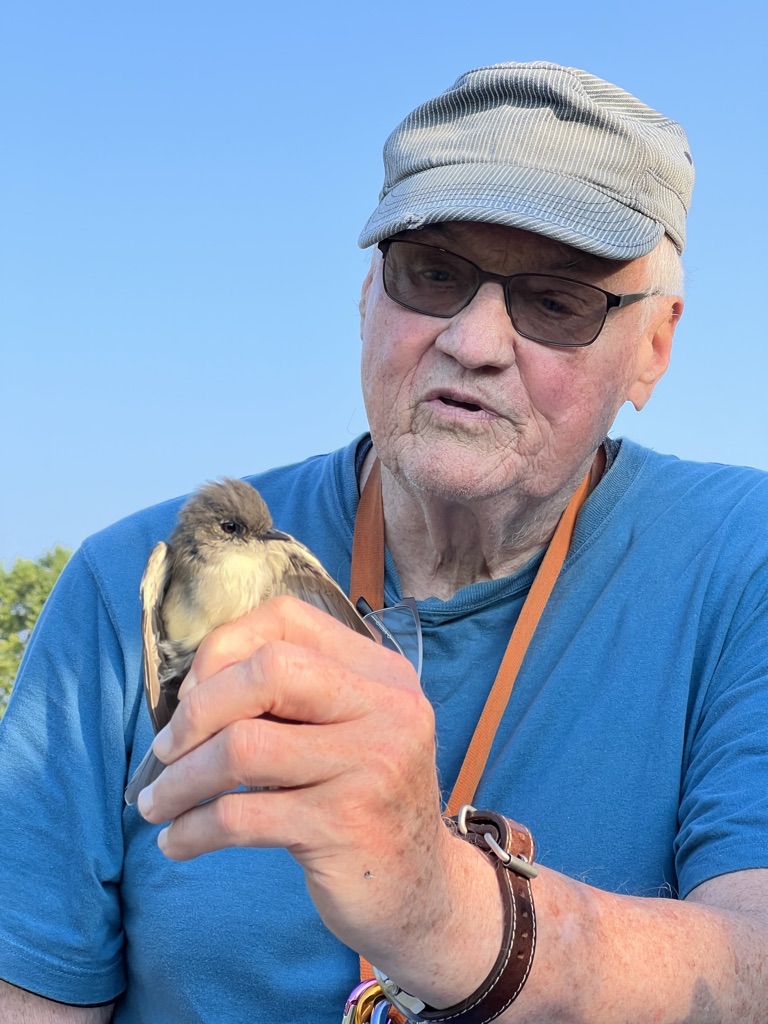
Hope to see anyone in the area at this informal discussion at the Traverse City Wild Birds Unlimited!
https://traversecity.wbu.com/ It will be on Saturday, September 9th at 10 AM. If you are curious about our local birds please come!

The waters of Lake Michigan are calm tonight, so calm they barely ripple and our pup can drink without wetting his paws. We walked south along the shore towards Whaleback and away from the Leland harbor.
I spotted a white bird which quickly resolved into a Common Merganser sitting on the shore just above the waterline. Aside from a few Ring-billed Gulls farther out bobbing in the water and a Song Sparrow singing from the spruces, there were no other birds.
As we approached the Common Merganser stood up and slowly floated away. And then we saw what had kept him ashore. A dead female Common Merganser lay on the sand, its neck twisted to the side. The male had stayed with her. After we passed he returned. When we passed again on the way back he again swam out and then returned to her side.
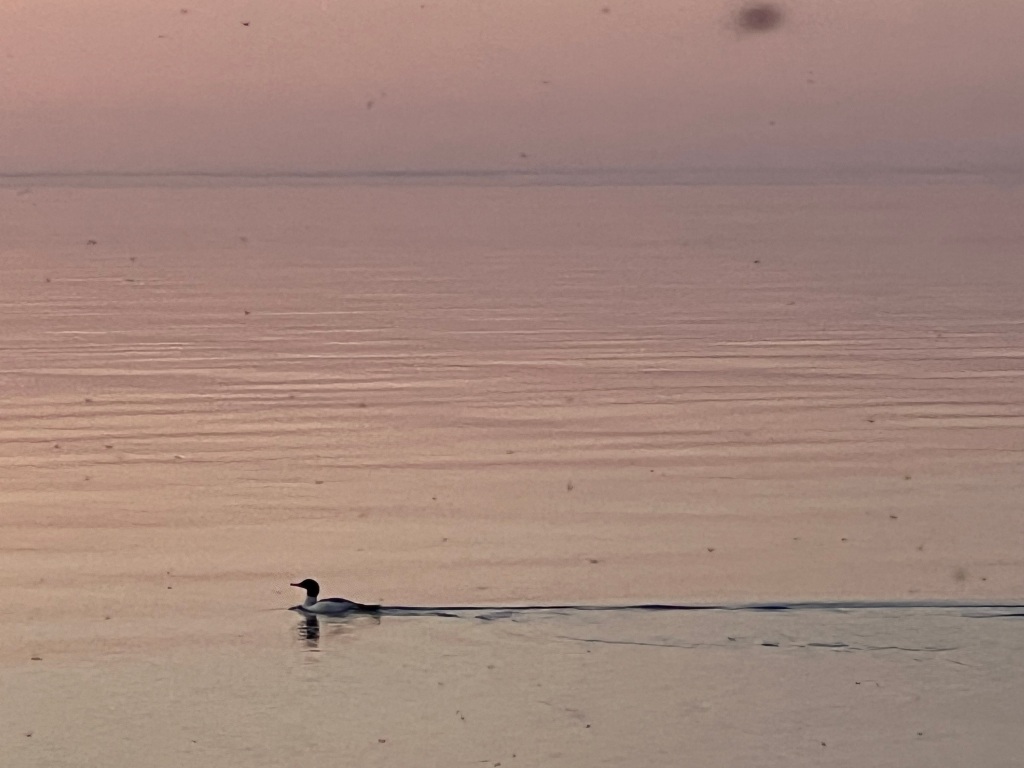
What was he thinking? She would not come back to life. Was he taking time to mourn her? Would he leave and continue north? Is it a little late for him to get to breeding grounds and find another mate? What did she die of?
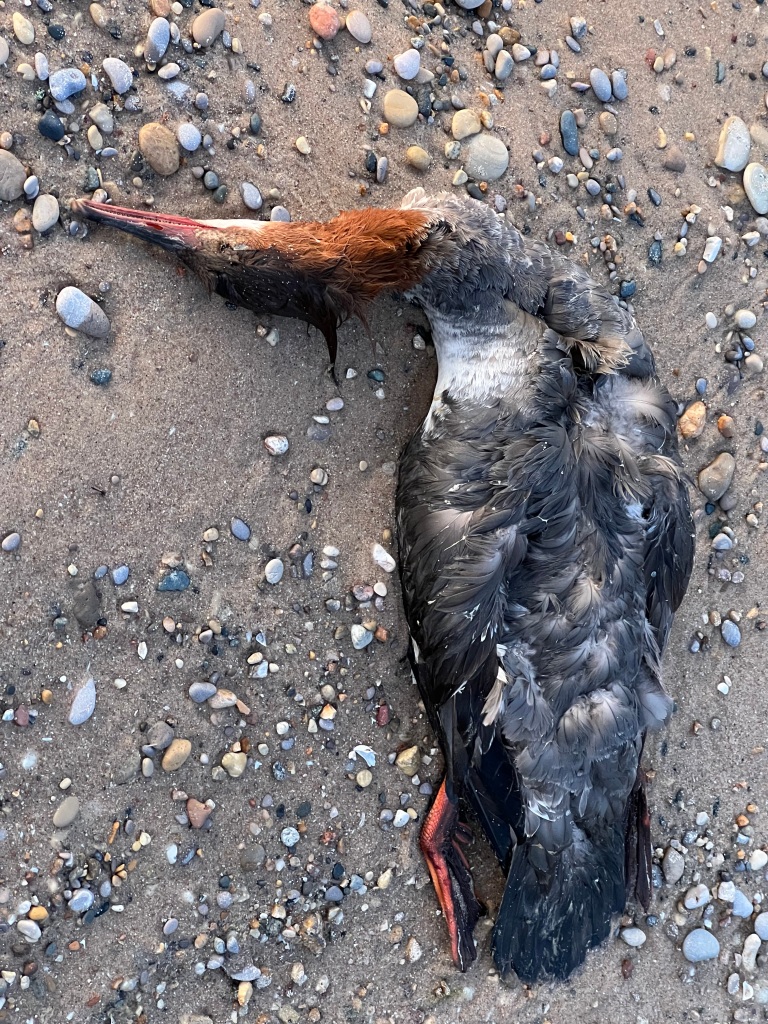
Annie Dillard in Fecundity says “Evolution loves death more than it loves you or me.” and that is the truth. Springtime for many is the time of rebirth, of birth, of impossible fecundity. And it is also the time of death, most commonly of the very youngest, those who do not make it out of the nest.
Death of his mate was not supposed to happen for this Common Merganser. His heartbreak is not what we like to see. Much better was the pair of Common Mergansers I saw 3 days ago on Whitefish Point. Each were alive and apparently healthy.
I wonder if he will be there tomorrow at the side of his chosen one. I wonder if it is known that Common Mergansers stick by their dead mates.

On December 14, 2022, I spent some time observing a new blackbird in Flynn Park. Its dark but slightly rusty color, pale eye and vocalization very different from Red-winged Blackbirds made me realize these birds were Rusty Blackbirds. I also had to rule out Brewer’s Blackbird and more easily the Common Grackle.
These Rusty Blackbirds were here for the winter. Or at least some were. I saw them most days on my morning walks through Flynn Park, particularly on the northern edge of the park or in the trees just north of it. Sometimes they were high and other times they were feeding in the mowed park grass. I grew to love their calls, somewhat melodious and reminiscent of water sounds but not as much as the Brown-headed Cowbirds which anyway I did not see in winter. I was glad that I ran into a colleague, David Sibley, who also identified them. And of course, Merlin heard and named them.
I saw 50 Rusty Blackbirds on March 3, 2023 and then another 50 on March 26, 2023 in Ruth Park, just as I was leaving. In Ruth Park they flew over to the park and the landed noisily in the trees. I did not stay to see what they would do next. Rad Widmer said he had seen hundreds of Rusty Blackbirds in Forest Park recently.

But now on April 10th I am not seeing so many Rusty Blackbirds. In fact, the last time I saw them was April 7th. How do I know all these numbers and dates so specifically? It is just from looking back at my eBird entries. I love how they compile them. And there I can also see that Rusty Blackbirds should still be in the area, though migration north has surely begun.
I would not think so much of the Rusty Blackbirds, except they are declining severely, down 85 to 95% from 1970 to 2010, according to Birds of the World. They are a hard one to get numbers on because they often mix in with Red-winged Blackbirds and Brewer’s Blackbirds, though the latter misses the easternmost areas. Also, Rusty Blackbirds breed in Canada and Alaska in the magnificent boreal forests. It is an area little covered by Breeding Bird Surveys or eBird records, though there are enough that this is how we know they have declined. And their more southern wintering grounds are covered by Christmas Counts.
I hope to see more Rusty Blackbirds before they are gone for the summer and maybe drive into Canada to see them on their breeding grounds, though they are not dense there and may be hard to find. I’ll look near water in northern bogs and lakes. I will from now on try to pay more attention to the blackbirds, not looking only for the occasional Yellow-headed Blackbird, but also for the more subtle differences of the Rusty and Brewer’s Blackbirds. Every bird matters.
A first-year male sat on a small branch in the sycamore at Route 66 State Park a few dozen miles west of my home. It flew out and caught an insect that was invisible to me. Then flew out again, changing its angle slightly so its most identifying characteristic became clear: a brilliant yellow rump. I had seen my first warbler of the spring. Of course this Myrtle Warbler could have overwintered right here in Missouri and I might have seen one earlier had I been in the right place. I’m confident that the American Ornithological Society’s North American Classification Committee will soon give this bird its rightful name and split it from Audubon’s Warbler in the west, so I’ll refrain from calling it Yellow-rumped Warbler. I’ve seen the genetic evidence and it is compelling for this split and others lumped under this name.
For now, I will just meditate on that first warbler of the year, so delicate and bright. Soon I saw another, a male in full color 50 yards down the row of sycamores. I immediately decided that these two birds had to know of each other’s presence, for they were the only two. And just as I thought that the youngster flew over to the older one and landed on a branch just inches above. They traded places and flew about each other for a few minutes, not exactly fighting, but making it clear they were aware of each other.
We moved on for we had somewhere soon to be. I was with the St. Louis Audubon Society and this was an official field trip led by Josh Uffman with the goal of seeing the American Woodcock display at and after dusk.
Route 66 State Park sounds nice, and it is. There is a bit of the asphalt of that original road across the country still left. But the actual location is the result of a disaster. In a town once called Times Beach, oil tainted with dioxin was sprayed on the dirt roads to keep the dust down. Once discovered, the town was abandoned, the site mitigated, but not safe for dwelling. The only remains of the homes that I could see were the anomalous blooming daffodils we came upon here and there along the paths.
We went on down 109 to where it met F and looked at the ponds behind the gas station, running out the clock until it would be dark enough for the woodcocks. Then we continued to Young Conservation Area and walked along the muddy path and across Labarque Creek, famous for aquatic biodiversity. And then we saw them. The second warbler of the year. We saw one and then another bobbing along the creek and then one sang. After all these birds were on their breeding territory. And there was no chance they had been here all winter for Louisiana Waterthrushes winter from Mexico south into Colombia and Venezuela and in the Caribbean Islands. Where our birds had come from I could not tell, but they were here now for us to watch as they foraged along the creek shore, likely a mated pair.
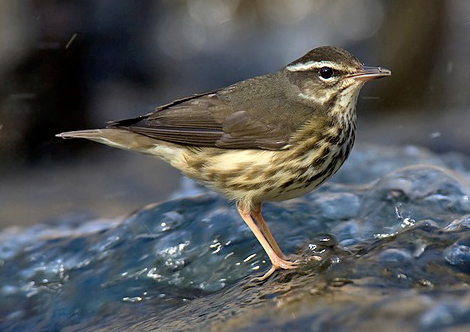
This early in St. Louis migration I can treasure these two, Myrtle Warbler and Louisiana Waterthrush. The former is just passing through to breed perhaps in Michigan or Wisconsin, but more likely in Canada somewhere. The later has found its breeding grounds along the pristine LaBarque Creek.
Dusk descended, then dark but not before we heard the nasal peent of an American Woodcock and watched him fly high up seemingly against the moon, and then down with a fluttering call. Again and again we watched. And then drove home through the dark into St. Louis.
Myrtle Warbler photo by Dan Pancamo from Wikimedia.
Louisiana Waterthrush photo by William Majoros from Wikimedia.
At 9 AM I met the camera person and the reporter at the visitor’s center in Forest Park. We were going to talk about Slow Birding for a local educational channel.
I wondered how it would go and who these people were, so I asked Terry Gross’s question: Tell me about yourself, and learned a lot.
We walked down the path and over into the meadow. I talked, she talked. I read from the book. I walked naturally. See what you think.
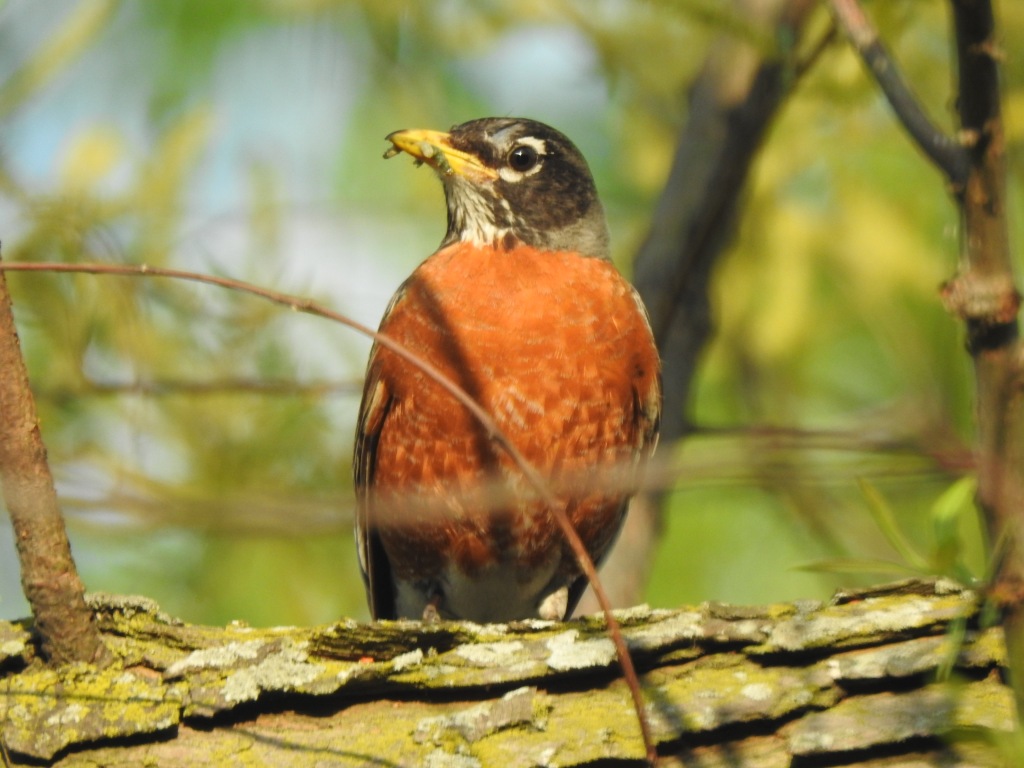
On this cold but sunny mid-March day, House Finches dominate the sunflower seeds I scattered in my back garden. I know their chatter very well. It is a happy sound, and when they sing, my husband says it might be the most common complex song we hear often. I know the wide finch beak and the soft chest stripes of the females. I know the red-orange cap and chest of the males well enough to wonder if this particular finch is particularly bright and therefore more attractive to the females around him.

These House Finches are so common it is easy to forget that the birds in my yard may be something else entirely. The females may have slightly stronger streaks on their chests. The orange-red may extend to the back of the head and stain the wings, dulling the wingbars. The song may be even more rapid than the House Finches. These birds may be Purple Finches, one of the birds of my Michigan childhood, one that winters here but breeds farther north.
I remind myself to pay attention and to see the rarer bird when the common one is so easy to see. I remind myself to really look and listen, not only at these two birds, but at all before me. What you are saying might not be what I think you are saying. I can only find out if I truly pay attention. So I’ll let the finches be a meditation on humility, that I may not see what I think I see and I will only discover this if I learn to really open myself to experience.

House Finch: Photo credit: By John Benson from Madison WI – Another House FinchUploaded by snowmanradio, CC BY 2.0, https://commons.wikimedia.org/w/index.php?curid=18690313
Purple Finch: By Cephas – Own work, CC BY-SA 3.0, https://commons.wikimedia.org/w/index.php?curid=15362339

At last there is a book Slow Birding and it has a lot of birds in it!
Don’t you wonder about your local birds? When I see the White-throated Sparrows that have arrived from their northern breeding grounds only recently scatter into the grasses, I wonder what they could tell me. Why are some males singing their haunting song? Do the Dark-eyed Juncos mixed in the flock benefit from these other birds?
What do we learn when we really watch birds? What can we learn from the people that have devoted their lives to them? These are the questions Slow Birding addresses. There are surprises in every chapter, from what is really going on with House Sparrows to master carpenter Northern Flicker. I hope you find time to read or listen to it. I narrated Slow Birding myself.
In April and May we can witness a great migration as songbirds stream north in rivers of life, so numerous weather radar sees clouds that are not storms but birds. These birds feather their way north to thawing breeding grounds leaving their tropical homes to eat and feed their young on the tender caterpillars feasting on delicate new northern leaves. Birds fly night and day, but above all in the night. They concentrate after crossing the Gulf of Mexico from Yucatán in places like Sabine Woods and High Island, both in Texas. They stop in Point Pelee, an Ontario finger into Lake Erie. They pause before crossing Lake Michigan at Chicago’s Montrose Point. And these are only a few of the natural concentrators that make the birds easy to find and watch.

In April and May Audubon Societies all across the US and Canada stage their biggest fund drive, the birdathon. And it is just what it sounds like: a team event where instead of miles the metric is bird species seen. So find your local Audubon Society and see if it has a birdathon. It is easy to put together a small team, embarrassing to ask your friends and colleagues to support your efforts, but it is for such a good cause: preservation of habitat, conservation education, and whatever else your Audubon society has found helps. When we make the world safer for birds, all natural life benefits.
This year I participated in two birdathons, one with the Houston Audubon Society and one with the St. Louis Audubon Society. The birds reach Texas before they reach Missouri, so birding my former home and my current home was feasible.

My husband and I rented a Bolivar beach house so we could enjoy the Texas migrants for several days. On the birdathon day we chose, Sunday, April 24, 2022, we were joined by our son Philip and met my sister Diana and colleague, friend, and star birder, Cin-Ty Lee at the ferry landing from Galveston. Our team was the Thieving Magpies. Here is our trip report, public on eBird. We checked out the pier and then went to a few places nearby. We walked out on the North Jetty watching the shorebirds and at a clump of vegetation, Cin-Ty knew to look for Nelson’s and Seaside Sparrows, both new birds for me, or lifers as the birders say. Some people eat blueberry pie when they see a lifer. I guess from that trip I have four pies coming to me.
We went on and watched the Reddish Egrets do their seemingly drunken dance in the water to fool the fish. We saw lots of Forsters Terns, Laughing Gulls, and an Iceland Gull only Cin-Ty could identify though we all spent a lot of time staring at it. There were two Red Knots and Cin-Ty soberly told us they may disappear in our lifetime. Perhaps you have heard of them and how they depend on the eggs of horseshoe crabs in mid-journey for their epic 10,000 mile south of South America to Arctic journey. The Brown Pelicans framed the view looking indestructible, though we nearly killed them off too with the pesticide DDT.
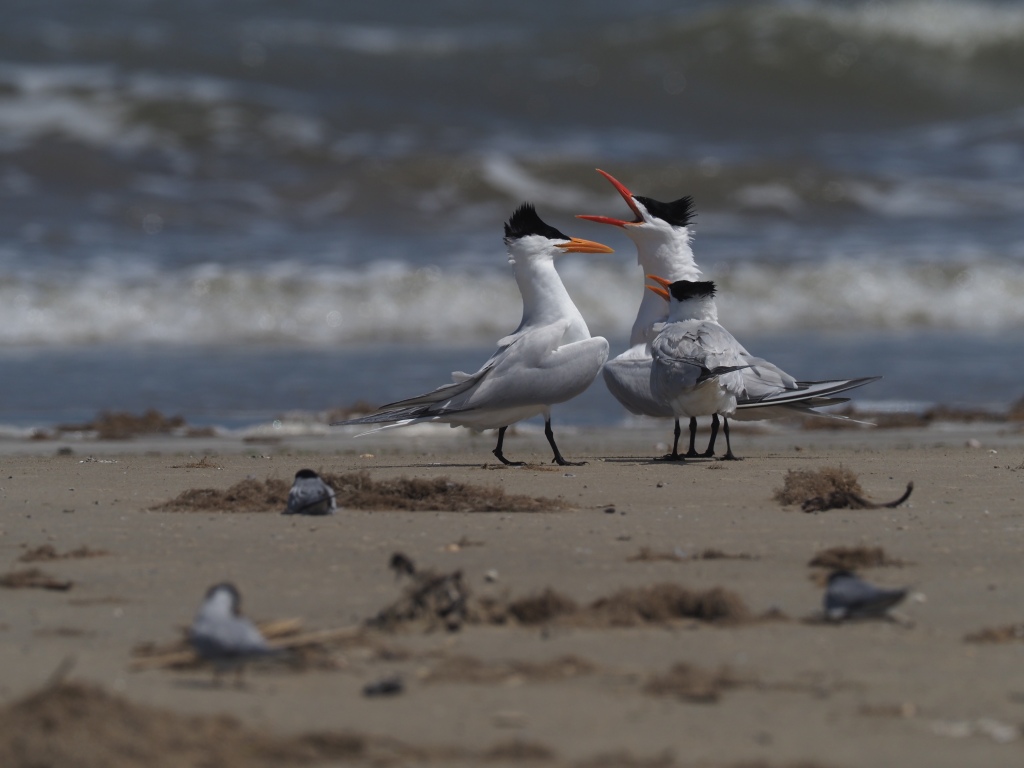
Finally it was time to go to the jewel of the coast, High Island, not an island at all, but an oil-rich salt dome rising just enough above the coastal marshes for oaks, pecans, mulberries, and other trees. It is the first place a bird crossing the gulf could land, should they need to. Best weather for birders lures the birds off Yucatán with east winds and then drops them if they face a punishing north wind as they hit the coast. But I never wish for those north winds, worrying about all the birds that never make it to land.
There are many places you can read about the sanctuaries of High Island, preserved by Houston Audubon and Texas Ornithological Society. And sanctuary is the right word, for if anything to me is holy, it is these scraps of woods preserved for migrating birds, as a shrine that provides food to refugees might also do. I could tell you a lot about High Island, but I want to leave you with just one image. It is that of a Rose-breasted Grosbeak. This male sat medium high in a leafing out pecan, its colors heart-stoppingly brilliant. Grosbeaks have large bills, as their name implies, but it is the heart-shaped vermillion-red badge on its chest that stops my own heart. A black head, Black and white wings and other colors complete this tuxedo-with-a-splash pattern. About 12 birders were arrayed under these trees right around the corner from the famous Boy Scout Woods bleachers, naming birds as they came in. There were other grosbeaks, male and female, Chestnut-sided Warblers, Baltimore Orioles and so many more. But this one grosbeak kept my eye, not because he was so perfect, but because he was not. His feathers were unkempt. He had not reached back to his preen oil gland with his bill and smoothed it on his feathers after the long flight. He was not feeding. But he did not otherwise look ill. I imagine him sitting their thinking with wonderment about the crossing, about flying all night and into the next day and then encountering a mild north wind. Perhaps he had some close calls on the journey. He certainly knew he had farther to fly, at least to Missouri and most likely up into Michigan or Canada.
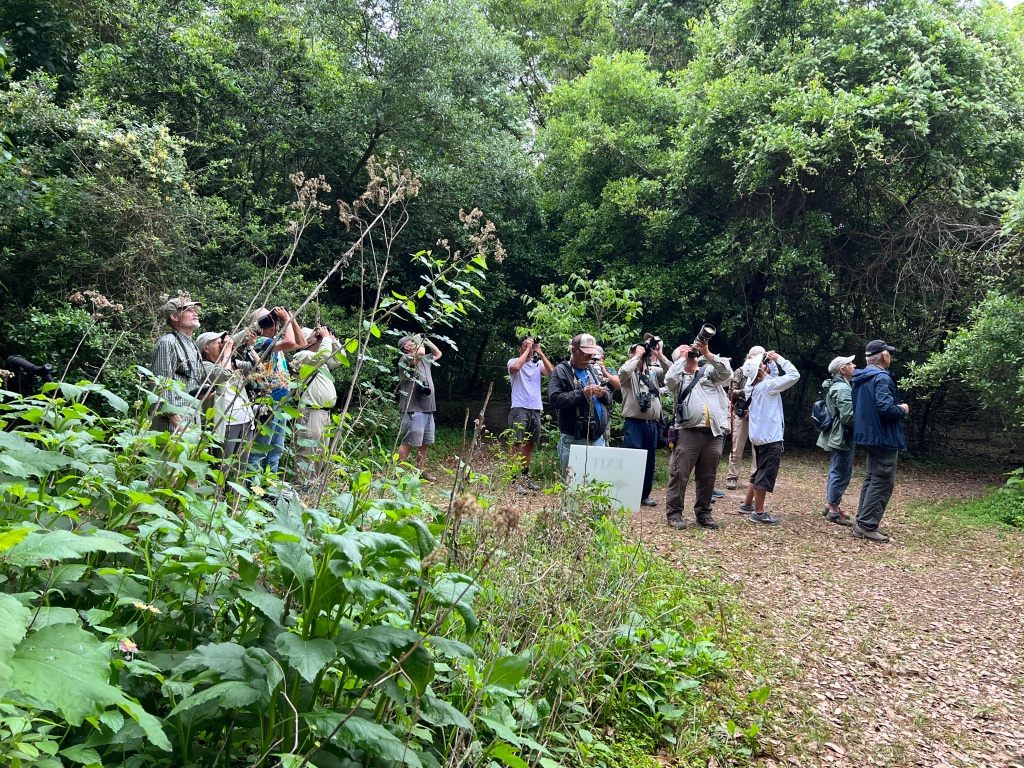
I wish I could say that while I watched this Rose-breasted Grosbeak shook himself and began the work of readying his feathers for the next journey. Or left his perch to begin foraging. But he did not. All may eventually be well with this bird friend, but all is not well with the birds. We are losing them by the billion. And habitat loss is the main reason. Loss in the tropics, loss on northern breeding grounds, and loss of stopovers all along the way.
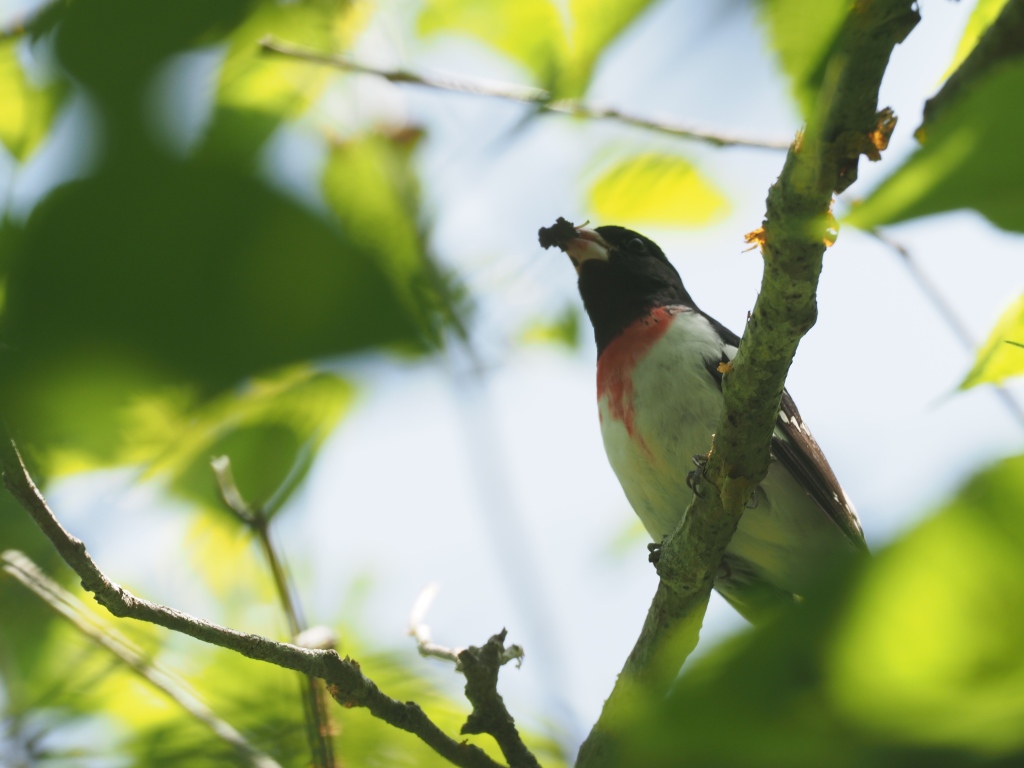
I hope the dollars I raised with this birdathon help slow this loss.
This post is long, so I will save news of the St. Louis birdathon for another day. Next year try to join a birdathon. Of course you are free to use your resources to support birds and all nature on any day of the year.
Springtime. Have you been paying attention? What are your springtime rituals for this so short season? At our departmental celebration yesterday of Carlos Botero’s achievement of tenure all were full of hiking and canoeing talk. The Ozarks beckon, though the creeks are high. Which trail will I hike next weekend? Bell Mountain? Hickory Canyon? Hawn State Park? Down to the Johnson Shut-ins? Or just the nearby Lewis and Clark Trail? Will it be walking, camping or backpacking? What are your plans?
I hear the spring peepers. I wonder if the salamanders have made their nighttime journey to the mating ponds at Tyson Research Center. The redbuds are tinging with color, blooms not quite burst. The weather is deceptive, coaxing us out of our jackets one sunny day, then shoving our arms back into sleeves on a blustery one with a morning near freezing.
In Flynn Park I heard Chipping Sparrows for the first time in a while. A lone Ruby-crowned Kinglet hopped from branch to branch, with the look I think of as round-eyed and surprised, unlike the Golden-crowned Kinglets we have had all winter with their sharp looking white eye shadow and darker streak through the eye. I see from my bird guide that the Ruby-crowned Kinglet winters only a little south of St. Louis, so I might have seen it deeper in the winter, but I did not.

A yellow-bellied Sapsucker also showed up in Flynn Park, pecking a methodical grid in a leafless treetrunk. It joined the woodpeckers I often see in Flynn Park, Downy Woodpeckers, Red-bellied Woodpeckers, and of course Yellow-shafted Flickers.
Walk a small park every day and the small changes with seasons will delight. I saw my first bird of the season carrying nesting material. It was a robin, a couple of days ago, April 3rd. At home I saw another, building a nest in the dogwood that shades our patio. Back in the park I saw a Common Grackle carry a beakful of something soft into the pines where they nested last year.
It is the small things that tell of early spring. I saw an Eastern Phoebe out here at Tyson and remembered a few years ago when I was challenged by the eBird monitor on an early phoebe sighting. I think I convinced him, though I did not have my trusty camera to photograph the truth. Who could mistake a tail-bobbing phoebe, perched above a rivulet?
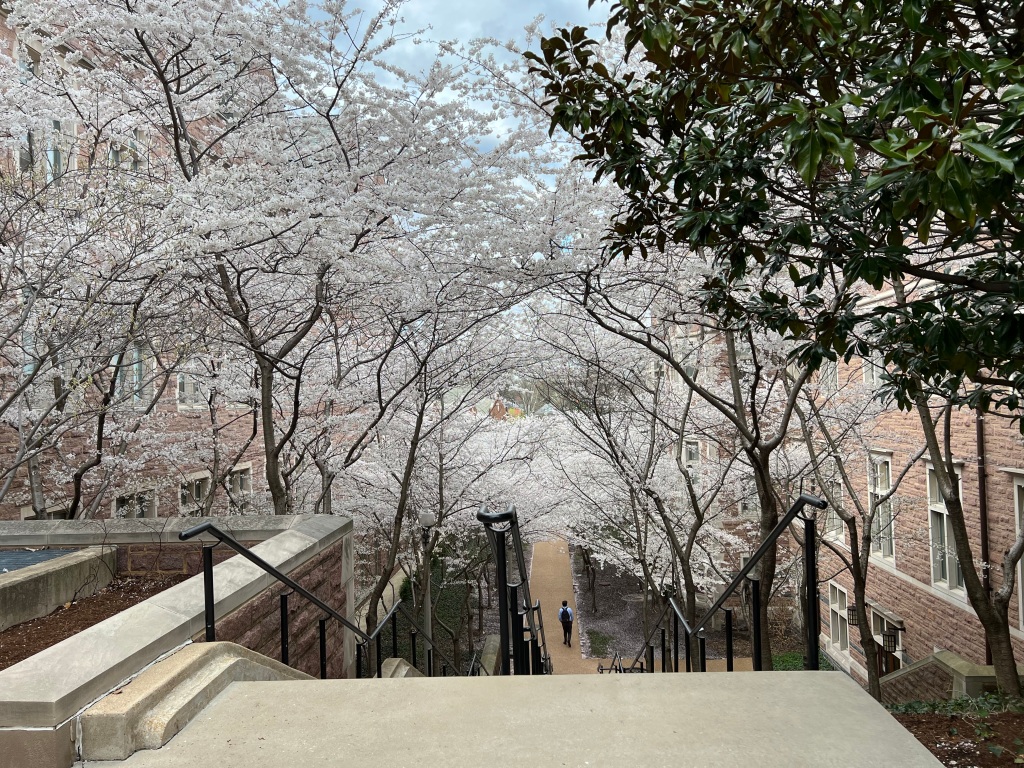
Spring is also a time of death. Sometimes my first realization of nesting birds are tiny bodies on the sidewalk. Many more deaths will come as young birds fail to learn to survive in a hungry world.
It is still a time of Covid-19 death, striking close to my heart against the most active and adventurous and made no less painful for the ebbing of this virus. NPR tells me we are at a low not reached since July 2021, but what does that mean to me, one relative gone forever? Inside my mask stays on. I am ready to bare my arm when the next booster is offered. Even in springtime life can end.

I did a double take when a Loggerhead Shrike appeared before me on the barbed wire separating the parking lot from train tracks since I had just seen a pair of Northern Mockingbirds in a nearby live oak. Of course there is no mistaking a Loggerhead Shrike for a Northern Mockingbird. They may share a lovely pattern of whites, grays, and blacks, but that is it. Shrikes have a wide, black mask from their beak to past their eye. But it is what birders call their jizz, or aspect and behavior that make them unmistakable.
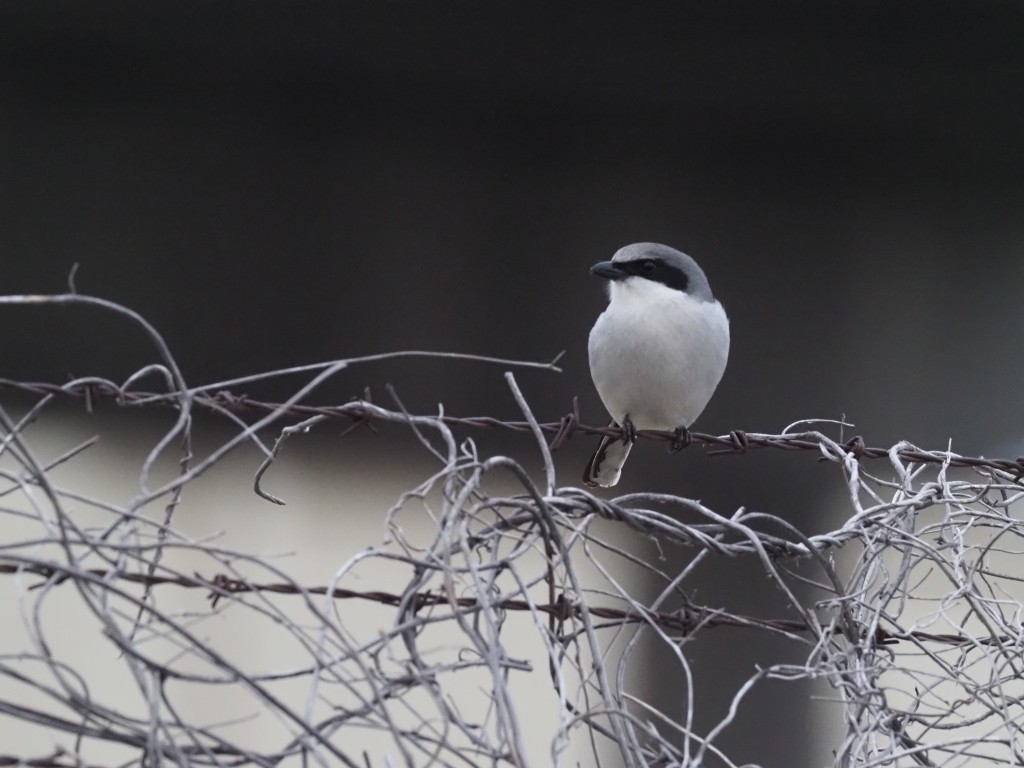
Mockingbirds are the singers of the bird world. They are slender as ballerinas while shrikes are chunky and seemingly neckless. Mockingbirds look up while shrikes look down.
I am in San Antonio in the part of town where I can see three bail bondsmen operations from the hotel. Freeway noise is incessant. On this early March day only the live oaks and palm trees still have leaves. Yet still I headed out, clicked eBird on to record anything I saw.
It was a breezy, overcast day, about 65F, just before 7 AM. The first 10 birds I saw were all House Sparrows, chattering and hidden in the live oaks and palms. I crossed W. Cesar E. Chavez and S. Frio and saw that the overpass we could see from the hotel went over railroad tracks. So I headed for the fence separating the back of the parking lot from those tracks. There would be the kind of scrubby vegetation that might have more than Rock Pigeons, White-winged Doves, Great-tailed Grackles, and House Sparrows.
And there, right on the wire was a Loggerhead Shrike. It sat there, watched me, then swooped low over the grasses and back up on the wire, trailing something in its bill. Had I witness the famous shrike hunting behavior? No, it simply had a piece of soft grass. When it flew off with it, I thought it probably had a nest over in the greater tangles of bushes and grasses under the overpass.
I love shrikes. They feel more accessible than other birds of prey since they hunt low, and cannot grasp their prey well in their talons, instead impaling it on spines or barbed wire. Maybe the barbed wire itself made hunting the railroad track verge attractive.

Shrikes feature in one of my favorite evolution papers, How the Horned Lizard got its Horns (1). In this story Kevin Young and Butch Brodie and his dad, also Edmund Brodie, looked at horns on flat-tailed horned lizards, inaccurately but commonly called horned toads. In 1996 and 1997 they got access to the Barry M. Goldwater Air Force Gunnery Range near Yuma, Arizona. There Kevin Young collected 29 skulls of dead lizards that shrikes had impaled, mostly on creosote twigs. For comparison they caught and measured 155 living lizards caught in the same area. They measured the pair of long horns on the top of the head, called parietal horns, and those on the side of the head, called squamosal horns.
This was field work at its best and worst, best because it was so cool, worst because it was on a bombing range. Butch said this about Kevin’s collecting: “He would cruise up and down the road just after dawn, picking skulls and carcasses from the trees and chasing live lizards into the bombing range. I remember that he developed a pretty uncanny tracking skill – when the sun was low, he could detect lizards’ tracks and follow them to where the lizards had buried into the sand to wait out the heat of the day!” That sounds wonderful, but this was along “ a narrow band of mesquite and other shrubs that grew between the dirt road and the bombing range.” That is the thing about field work. Our organisms are not always most easily studied in pristine habitats.
Their prediction was that the lizards that had been killed by shrikes would have shorter, narrower horns if horns had evolved to protect lizards from shrike attack. And this is exactly what they found. It is evolution in action, with the shrikes attacking those with shorter horns more successfully.
I took a look at Loggerhead Shrikes in Cornell’s Birds of the World and was stunned to see they are listed as near threatened (2). They have vanished in many northern places since the 1970s, so I guess I’m lucky to be in San Antonio (2). It is not entirely clear why this happened, but some likely reasons include the reforesting of New England with the failure of their rocky farms. In the south, fire ants compete with them for food. Loggerhead shrikes need open grasslands with enough trees or bushes for their nests, as might be the case with hedges between grassy fields. The situation is so bad that Loggerhead Shrikes are categorized as endangered in Indiana, Ohio, Wisconsin, and my home state of Michigan.
Loggerhead Shrikes in Texas are quite sedentary, so I imagine this pair may stay their entire lives in this scrub land no one wants and few have access to. I wonder if it is part of a population that finds wildness in cities along tracks, extending out of town, just as prairie seeds are sometimes found along the tracks, brought in on muddy train cars. But it turns out that linear habitats are not necessarily good for shrikes (3). Reuven Yosef watched 27 banded pairs of Loggerhead Shrikes in 1992 at Archbold Biological Station in Florida. The part of the landscape he studied was a huge cattle ranch with lots of fencelines. He compared nest failure rates of nests along the fencelines to those in bushes and trees out in the pasture and found that predation was much more common along the fencelines, presumably because the predators learned to hunt for nests there. This made Yosef wonder if linear habitat preservation is enough to protect declining bird species.
I just have to tell you one more thing about shrikes that is too cool. It turns out they are good at avoiding toxins, either by eviscerating their prey or by aging it until the toxins denature and become inactive (4). The lubber grasshopper is big, flightless, and has bright yellow stripes on its abdomen which it shows off to potential predators. It squirts out a poison that it has sequestered from the plants it eats and it contains toxic phenols, quinones and allelochemicals. Most birds don’t eat these grasshoppers and one captive Eastern Meadowlark that did died three days after eating them. But it turns out that Loggerhead Shrikes have a trick that makes these big grasshoppers edible.
Reuven wondered about this after he saw that shrikes impaled lots of lubber grasshoppers. The first experiment he did was to offer the grasshoppers to juveniles. They started to eat them and then “disgorged and dropped prey, gagged (held mouth open), stuck out tongue, dripped saliva, squawked, and shook head back and forth (p. 531).” Then they did not try any more, so clearly grasshoppers were distasteful eaten straight up. In the second experiment, Yosef offered the grasshoppers to adults and found that they either ignored them, or impaled them on the barbed wire in their cages. Then they ate them only a day or two later when the dead grasshopper color changed from bright yellow to brown. They ate only the head and abdomen, always rejecting legs, wings, and the thorax, the latter being where the defensive glands were (4). In the final experiment they gave the caged shrikes frozen grasshoppers, some of which had been frozen fresh and were still bright yellow and some of which were frozen after aging to brown. Again, shrikes only ate the brown ones and only the head and abdomen, unlike what they did with other kinds of grasshoppers lacking toxins.
There are so many interesting things to learn about Loggerhead Shrikes. Those involving predation are made easier to study because of the way they impale prey, allowing us to see it. If I were here a month or two later, I would look along the tracks and see if I could watch young shrikes learn to impale their prey, sometimes failing, sometimes wedging them rather than impaling, and sometimes feasting on a well-caught prey. I might even see them learn about the nastiness of unaged lubber grasshoppers if they occur in Texas.
1. K. V. Young, E. D. Brodie Jr, E. D. Brodie III, How the horned lizard got its horns. Science, (2004).
2. R. Yosef, in Birds of the World, A. F. Poole, F. B. Gill, Eds. (Cornell Laboratory of Ornithology, Ithaca, New York, 2020).
3. R. Yosef, The effects of fencelines on the reproductive success of Loggerhead Shrikes. Conservation Biology 8, 281-285 (1994).
4. R. Yosef, D. W. Whitman, Predator exaptations and defensive adaptations in evolutionary balance: no defence is perfect. Evolutionary Ecology 6, 527-536 (1992).